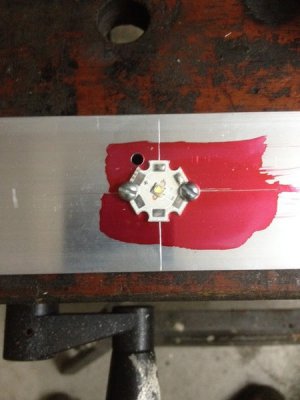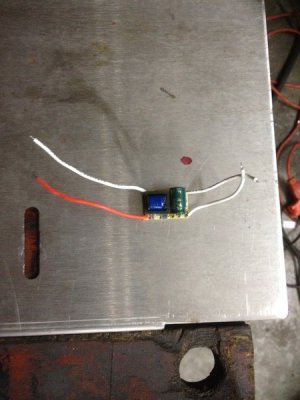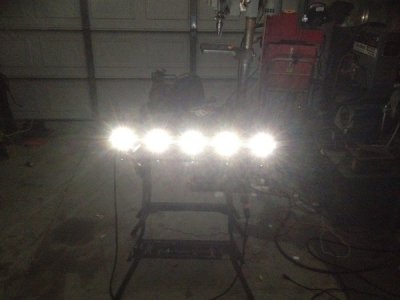- Joined
- Feb 2, 2013
- Messages
- 3,627
I've been in the planning stages for too long on an idea for retrofitting my shop light.
Above my bench there is a 4' - 2 bulb, fluorescent T8 fixture, that i'm retrofitting with LED lighting.
I traded the LED's , drivers, and filters from a member- Matthemuppet , awhile ago and haven't put them to use until now....

I ordered some 1/8" x 2" x 36" 6061 aluminum flat to use as the mount and heatsink for the build.

using the 1watt LED as a template. i laid out the locations and marked out the hole positions for drilling/tapping 6-32 attachment screws and bored holes for pass thru of the wiring in the aluminum flat.
I used Heat Sink Compound on the LED/Aluminum flat interface for maximum heat transfer. The Flat is not only the support structure, but it's lot of area for heat dissipation!

I decided against using the machine screws because the heads were too large and presented a possible electrical malfunction or a short in the circuit that i want to avoid.
i chose instead , for socket head cap screws (allen head) due to their smaller head diameter.
the smaller head doesn't interfere with electrical conductivity of the LED.

here's a look at the LED driver, it's really quite simple.
to utilize the driver you'll apply 110v to the white legs on the right side of the picture.
the driver steps the voltage down to just over 13vdc.
The Red wire is +, the Other White is -.
Led's should not be hooked up in parallel, premature failure is likely.
This circuit is a series connection, there is 5- 1 watt led's in the circuit.
I soldered up the series connections directly on the led's and wire nutted the driver in for testing purposes.
here's the test photo,
these are the only lights on in the shop!

i ran the test for 15 minutes without smoke or flames, so something must have went right!!!
in the next episode, i'll be mounting the array into the shell of the old shop light and reassembling.
as always thanks for reading, comments/questions are always welcome!
Above my bench there is a 4' - 2 bulb, fluorescent T8 fixture, that i'm retrofitting with LED lighting.
I traded the LED's , drivers, and filters from a member- Matthemuppet , awhile ago and haven't put them to use until now....

I ordered some 1/8" x 2" x 36" 6061 aluminum flat to use as the mount and heatsink for the build.

using the 1watt LED as a template. i laid out the locations and marked out the hole positions for drilling/tapping 6-32 attachment screws and bored holes for pass thru of the wiring in the aluminum flat.
I used Heat Sink Compound on the LED/Aluminum flat interface for maximum heat transfer. The Flat is not only the support structure, but it's lot of area for heat dissipation!

I decided against using the machine screws because the heads were too large and presented a possible electrical malfunction or a short in the circuit that i want to avoid.
i chose instead , for socket head cap screws (allen head) due to their smaller head diameter.
the smaller head doesn't interfere with electrical conductivity of the LED.

here's a look at the LED driver, it's really quite simple.
to utilize the driver you'll apply 110v to the white legs on the right side of the picture.
the driver steps the voltage down to just over 13vdc.
The Red wire is +, the Other White is -.
Led's should not be hooked up in parallel, premature failure is likely.
This circuit is a series connection, there is 5- 1 watt led's in the circuit.
I soldered up the series connections directly on the led's and wire nutted the driver in for testing purposes.
here's the test photo,
these are the only lights on in the shop!

i ran the test for 15 minutes without smoke or flames, so something must have went right!!!
in the next episode, i'll be mounting the array into the shell of the old shop light and reassembling.
as always thanks for reading, comments/questions are always welcome!


